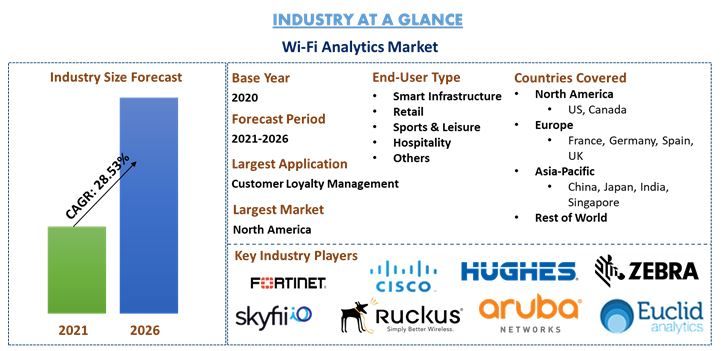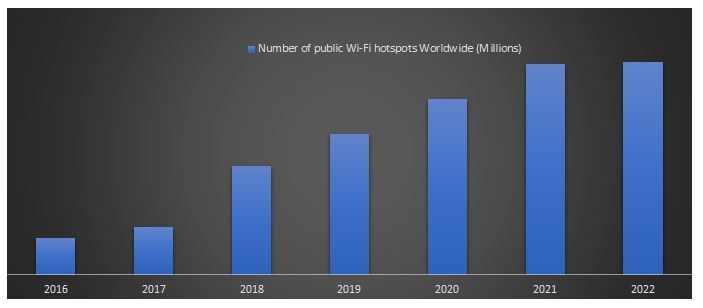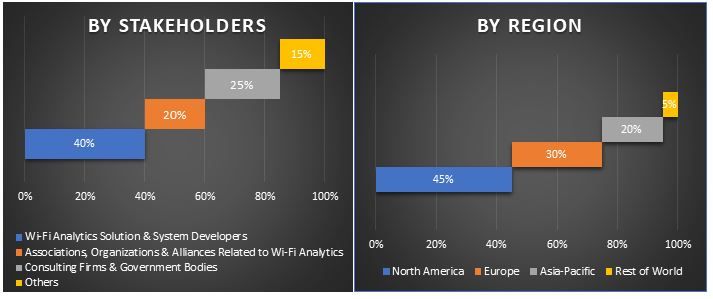- Home
- About Us
- Industry
- Services
- Reading
- Contact Us
Global Wi-Fi Analytics Market: Current Analysis and Forecast (2020-2026)
Emphasis on Component (Solutions, Services), Deployment (On-Premises, Cloud), Application (Footfall Analytics, Customer Engagement, Customer Experience Management, Customer Behavior Analytics, Customer Loyalty Management), End-Users (Smart Infrastructure, Retail, Sports & Leisure, Hospitality, Others) and Region/Country
The global Wi-Fi Analytics market was valued at US$ 5.5 billion in 2019 and is projected to expand significantly with a CAGR of 28.53% from 2021 to 2026. The global Wi-Fi Analytics market is expected to witness a boost, owing to the increasing use of smartphones and smart devices.
Wifi analytics mainly refers to the use of a collection of Wi-fi networks to gather the data on Wi-fi devices such as smartphones, laptops, and other electronic devices. The adoption of wi-fi analytics purposes to support organizations of every size in building extensive consumer profiles and to better understand the consumer behavior within their reach. The concept has emerged as one of the most widespread and versatile connectivity solutions.
Factors such as increasing smartphone penetration and the rise in the adoption of the Internet of Things showcase lucrative opportunities for business expansion. Moreover, rising competition from online and offline retail business and deployment of public Wi-Fi across physical venues has led to significant growth of the market. Besides, the initiative by the government for smart city development across several regions has further accelerated the growth of the public Wi-Fi hotspots that contribute to the industry growth.
However, with the ongoing pandemic threat, although the average number of connected devices in the home is estimated to range from seven to ten, depending on the region, the trend is clearly towards an increase to twenty, thirty, or more, in the next few years, due to the proliferation of devices and IoT. With more users in the home simultaneously active online owing to remote working across the regions, the Wi-Fi network tends to suffer overload and decreased performance. For instance, the COVID-19 impact on home Wi-Fi usage has led to a decrease in the Quality of Experience (QoE). Some operators are experiencing a 40% increase in the number of call center complaints due to low internet speed. Slow Wi-Fi speed is the prime reason triggering service calls, followed closely by unstable Wi-Fi.
Number of public Wi-Fi hotspots worldwide from 2016 to 2022
Cisco Systems Inc., Zebra Technologies, Ruckus Wireless, Aruba Networks, Inc., Purple Wi-Fi Ltd, Cloud4wi, Fortinet Inc., SkyFii Limited, Euclid and Hughes Network Systems LLC are some of the prominent players operating in the global Wi-fi Analytics market. Several M&A’s along with partnerships have been undertaken by these players to facilitate costumers with hi-tech and innovative products.
Insights Presented in the Report
“Amongst component, Solutions segment hold the major share”
Based on component type, the market is fragmented into solutions and services. The solutions segment dominated the Wi-Fi analytics market with a revenue of US$ 4.1 billion in 2019 and is expected to grow at a CAGR of 27.13% over the forecast period. The growth in the Wi-Fi analytics solutions segment is driven by the growing significance of customer analytics in brick-and-mortar businesses.
“Amongst deployment, On-Premise is expected to dominate the market during the analyzed period”
Based on the market segment by deployment, the market is segmented into on-premise and cloud. In 2019, On-Premise occupied around 63.8% of market revenue share. While Cloud is expected to be the fastest-growing segment in the global market. Wi-Fi analytics enables an organization in using the information available through the wireless network, to make better decisions about its physical space.
“Amongst Application, customer loyalty management is expected to dominate the market during the analyzed period”
Based on the market segment by application, the market is fragmented Footfall Analytics, Customer Engagement, Customer Experience Management, Customer Behavior Analytics, Customer Loyalty Management and Other Applications. In 2019, customer loyalty management accounted for the maximum market share with 34.1% and is expected to be the leading segment of the Wi-fi analytics market during the forecast period.
“Amongst end users, the Retail sector is expected to dominate the market during the analyzed period”
Based on the market segment by end-users, the market is fragmented into smart infrastructure, retail, sports& leisure, and hospitality. In 2019, the retail sector accounted for the maximum market share with 46.36% and is anticipated to lead throughout the forecast period. Surging online retail business and the number of hotels and restaurants providing a Wi-Fi platform, which offers several tools to incentivize their guests has led to the expansion in their brand presence.
“North America represents one of the largest markets of the Wi-Fi Analytics market”
For a better understanding of the market dynamics of the Wi-Fi Analytics market, a detailed analysis was conducted for different regions across the globe including North America (the U.S, Canada, and the Rest of North America), Europe (Germany, France, Italy, Spain, United Kingdom and Rest of Europe), Asia-Pacific (China, Japan, India, Australia and Rest of APAC) and Rest of the World has been conducted. North America dominated the market and generated revenue of US$ 2.2 billion in 2019. The market growth prospects are attributed to the growing significance of big data analytics and spur in investments in the latest technologies by the major players in the region. However, the APAC region is expected to witness the highest CAGR growth of 32.25% during the forecast period 2021-2026.
Reasons to buy this report:
- The study includes market sizing and forecasting analysis validated by authenticated key industry experts
- The report presents a quick review of overall industry performance at one glance
- The report covers an in-depth analysis of prominent industry peers with a primary focus on key business financials, product portfolio, expansion strategies, and recent developments
- Detailed examination of drivers, restraints, key trends, and opportunities prevailing in the industry
- The study comprehensively covers the market across different segments
- Deep dive regional level analysis of the industry
Customization Options:
The Wi-fi Analytics Market can further be customized as per the requirement or any other market segment. Besides this, UMI understands that you may have your own business needs, hence feel free to connect with us to get a report that completely suits your requirements.
Table of Content
Analyzing the historical market, estimation of the current market, and forecasting the future market of the Global Wi-Fi Analytics Market were the three major steps undertaken to create and analyze the adoption of Wi-Fi Analytics across the different industry in major regions globally. Exhaustive secondary research was conducted to collect the historical market numbers and estimate the current market size. Secondly, to validate these insights, numerous findings and assumptions were taken into consideration. Moreover, exhaustive primary interviews were also conducted, with industry experts across the value chain of the Wi-Fi Analytics sector. Post assumption and validation of market numbers through primary interviews, we employed a top-down approach to forecast the complete market size. Thereafter, market breakdown and data triangulation methods were adopted to estimate and analyze the market size of segments and sub-segments the industry pertains to. Detailed methodology is explained below:
Analysis of Historical Market Size
Step 1: In-Depth Study of Secondary Sources:
Detail secondary study was conducted to obtain the historical market size of the Wi-Fi Analytics through company internal sources such as annual report & financial statements, performance presentations, press releases, etc., and external sources including journals, news & articles, government publications, competitor publications, sector reports, third-party database, and other credible publications.
Step 2: Market Segmentation:
After obtaining the historical market size of the Wi-Fi Analytics market, we conducted a detailed secondary analysis to gather historical market insights and share for different segments & sub-segments for major regions. Major segments included in the report as component, deployment, application, and end-users. Further country-level analyses were conducted to evaluate the overall adoption of the Wi-Fi Analytics in that region.
Step 3: Factor Analysis:
After acquiring the historical market size of different segments and sub-segments, we conducted a detailed factor analysis to estimate the current market size of Wi-Fi Analytics. Further, we conducted factor analysis using dependent and independent variables such as rising demand for internet connectivity and surging deployment of public Wi-fi, government initiatives for smart city development and increasing adoption of big data analytics. A thorough analysis was conducted for demand and supply-side scenario considering top partnerships, merger and acquisition, business expansion, and product launches in the Wi-Fi Analytics industry across the globe.
Current Market Size Estimate & Forecast
Current Market Sizing: Based on actionable insights from the above 3 steps, we arrived at the current market size, key players in the Wi-Fi Analytics market, and market shares of the segments. All the required percentage shares split, and market breakdowns were determined using the above-mentioned secondary approach and were verified through primary interviews.
Estimation & Forecasting: For market estimation and forecast, weights were assigned to different factors including drivers & trends, restraints, and opportunities available for the stakeholders. After analyzing these factors, relevant forecasting techniques i.e. top-down approach was applied to arrive at the market forecast about 2026 for different segments and subsegments across the major markets globally. The research methodology adopted to estimate the market size encompasses:
- The industry’s market size, in terms of value (US$) and the adoption rate of Wi-Fi Analytics across the major markets
- All percentage shares, splits, and breakdowns of market segments and sub-segments
- Key players in the Wi-Fi Analytics market in terms of services offered. Also, the growth strategies adopted by these players to compete in the fast-growing market
Market Size and Share Validation
Primary Research: In-depth interviews were conducted with the Key Opinion Leaders (KOLs) including Top Level Executives (CXO/VPs, Sales Head, Marketing Head, Operational Head, and Regional Head, Country Head, etc.) across major regions. Primary research findings were then summarized, and statistical analysis was performed to prove the stated hypothesis. Inputs from primary research were consolidated with secondary findings, hence turning information into actionable insights.
Split of Primary Participants in Different Regions
Market Engineering
Data triangulation technique was employed to complete the overall market estimation and to arrive at precise statistical numbers of each segment and sub-segment of the Wi-Fi Analytics market. Data was split into several segments & sub-segments post studying various parameters and trends in the areas of the component, deployment, application, and end-users of the Wi-Fi Analytics market.
The main objective of the Wi-Fi Analytics Market Study
The current & future market trends Wi-Fi Analytics were pinpointed in the study. Investors can gain strategic insights to base their discretion for investments from the qualitative and quantitative analysis performed in the study. Current and future market trends were determined the overall attractiveness of the market at a regional level, providing a platform for the industrial participant to exploit the untapped market to benefit as a first-mover advantage. Other quantitative goals of the studies include:
- Analyze the current and forecast market size of Wi-Fi Analytics in terms of value (US$). Also, analyze the current and forecast market size of different segments and sub-segments
- Segments in the study include areas of component, deployment, application, and end-users
- Define and analysis of the regulatory framework for the Wi-Fi Analytics sector
- Analyze the value chain involved with the presence of various intermediaries, along with analyzing customer and competitor behaviors of the industry
- Analyze the current and forecast market size of the Wi-Fi Analytics market for the major region
- Major regions studied in the report include North America (the U.S and Canada), Europe (Germany, France, Spain, and United Kingdom), Asia-Pacific (China, Japan, India, and Singapore), and the Rest of the World
- Company profiles of the Wi-Fi Analytics market and the growth strategies adopted by the market players to sustain in the fast-growing market
Deep dive regional level analysis of the industry
Related Reports
Customers who bought this item also bought













